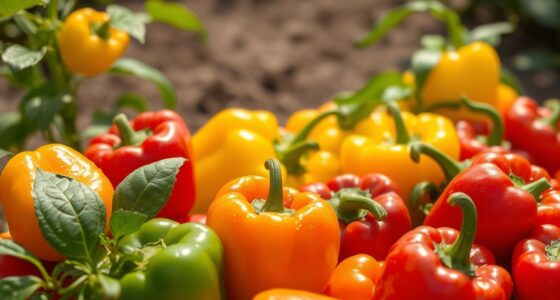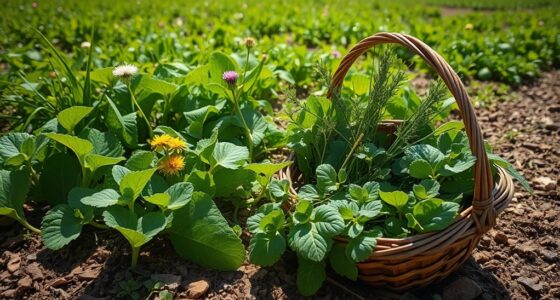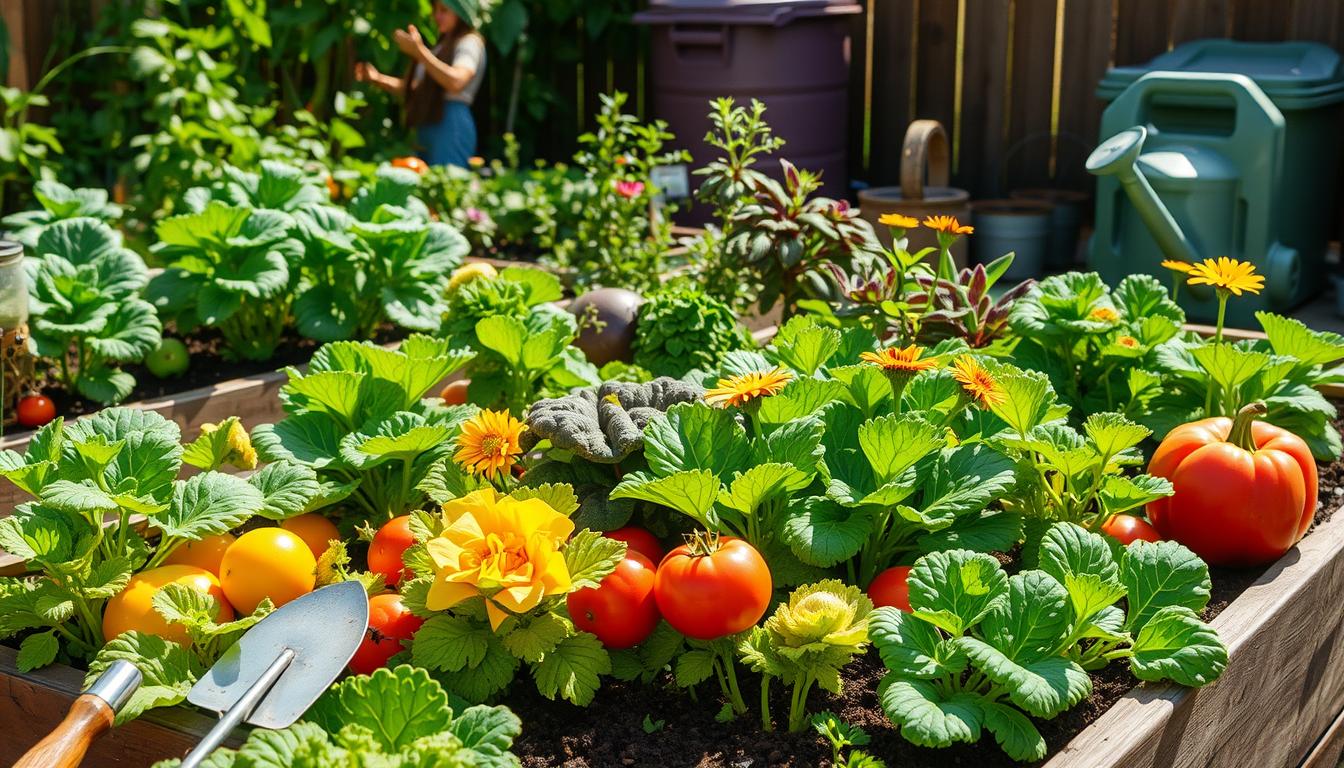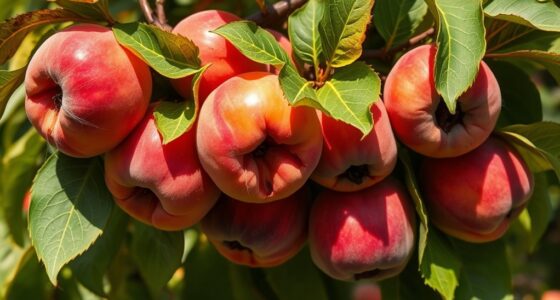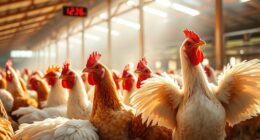To boost your yields with a pollinator-friendly garden, plant a diverse mix of native, nectar-rich flowers that bloom at different times to guarantee continuous food. Minimize pesticide use and create habitats like bee hotels and bare soil patches for nesting. Incorporate habitat corridors and water sources for pollinator movement and hydration. Maintaining natural, undisturbed areas will support native bees and beneficial insects. Keep exploring to discover more simple ways to make your garden thrive organically.
Key Takeaways
- Incorporate native, nectar-rich flowering plants that bloom at different times for continuous pollinator support.
- Create native bee habitats like ground nests, bee hotels, and habitat corridors to encourage pollinator presence.
- Minimize or eliminate pesticide use, opting for organic methods to protect pollinators and ensure healthy pollination.
- Maintain habitat diversity by avoiding excessive mulching and providing shallow water sources for pollinator hydration.
- Connect garden areas with corridors to facilitate pollinator movement and enhance overall ecosystem resilience.
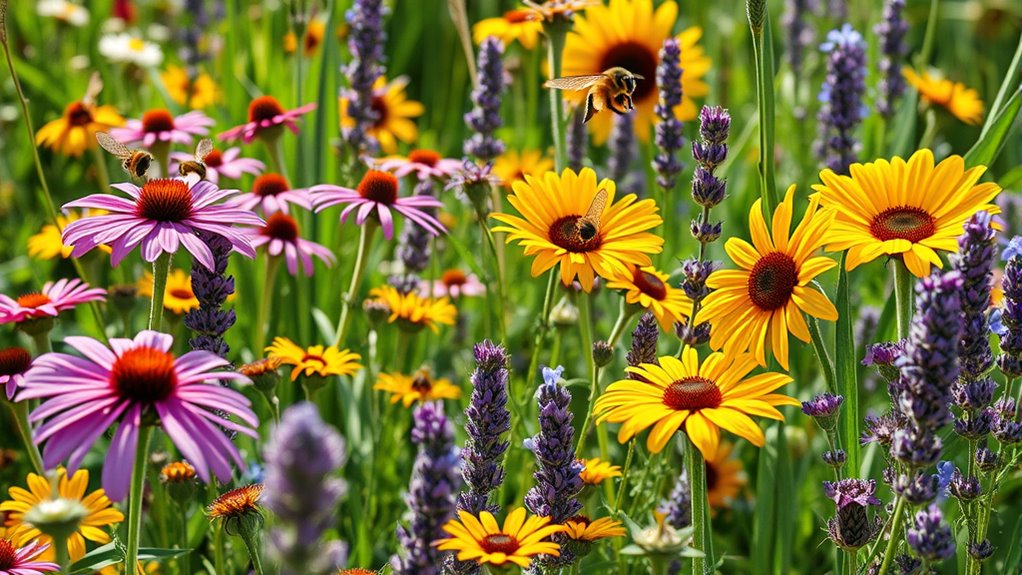
Creating a pollinator-friendly garden is one of the best ways to support bees, butterflies, and other essential insects. By designing your garden with native bee habitats in mind, you provide these vital pollinators with safe spaces to forage, nest, and thrive. Native bees, unlike honeybees, often rely on specific plants and habitats found locally, so incorporating native flowering species ensures they find the food and shelter they need. You can create small ground nests by leaving patches of bare soil, or set up bee hotels to support solitary species. These habitats not only benefit native bees but also contribute to the overall health of your garden ecosystem, leading to more effective pollination of your plants.
Design your garden with native bee habitats—provide food, shelter, and nesting sites for thriving pollinator populations.
Reducing pesticide use is a crucial step in establishing a pollinator-friendly garden. Many pesticides, especially neonicotinoids, pose serious risks to insects, impairing their ability to forage, reproduce, and survive. By choosing organic or integrated pest management (IPM) techniques, you minimize harm to pollinators while still controlling pests effectively. Handpicking pests, encouraging natural predators, and applying organic sprays only when necessary can dramatically cut pesticide exposure. This safer approach creates a healthier environment for pollinators and prevents the decline of native bee populations, which are already under threat from habitat loss and disease.
Plant selection plays a key role in attracting pollinators and boosting yields. Focus on a diverse mix of native flowers that bloom at different times of the year, ensuring a continuous food source. Bright, nectar-rich plants like milkweed, coneflowers, bee balm, and goldenrod draw in bees and butterflies, increasing pollination activity in your garden. The more effectively pollinators visit your plants, the better your crops will set fruit and produce seeds. A variety of blooms also attracts a broader range of insects, supporting a resilient and thriving pollinator community.
Finally, maintaining a habitat that appeals to native pollinators encourages their presence year-round. Avoid excessive mulching, which can smother ground-nesting bees, and leave some areas undisturbed to serve as nesting sites. Providing shallow water sources with landing areas helps insects hydrate and stay healthy. Regularly monitoring your garden for pests and providing alternative food sources during off-peak seasons ensures your pollinator habitat remains vibrant and productive. Incorporating proper storage techniques for seeds and plant materials can further preserve and protect these valuable resources. Additionally, understanding the importance of native plant diversity can help you select species that support a wide range of pollinators. Creating habitat corridors by connecting different areas of your garden can facilitate pollinator movement and increase their resilience to environmental stresses. Emphasizing native plant gardening practices can enhance the overall attractiveness of your garden to pollinators. Incorporating climate-resilient plants can further ensure your garden remains a supportive habitat despite changing weather patterns. By making these small but impactful adjustments, you create a garden that not only benefits pollinators but also greatly improves your plant yields, fostering a more sustainable and fruitful gardening experience.
Frequently Asked Questions
Which Native Plants Attract the Most Pollinators?
When considering native plant selection, you want to focus on those that attract the most pollinators based on pollinator preferences. Native plants like milkweed, goldenrod, and bee balm are highly attractive to bees, butterflies, and hummingbirds. These plants provide essential nectar and pollen, encouraging pollinator visits. By choosing native species aligned with pollinator preferences, you’ll create a vibrant, thriving garden that boosts pollination and increases your yields naturally.
How Can I Prevent Pests in My Pollinator Garden?
Imagine your garden as a lively sanctuary, buzzing with pollinators. To keep pests at bay, try companion planting—strategically placing herbs like basil and marigolds next to your blooms. These act as natural repellents, warding off unwanted critters while inviting beneficial insects. Regularly inspect your plants, remove pests early, and avoid chemical pesticides. This harmonious approach keeps your garden thriving, ensuring pollinators stay safe and your yields flourish.
What Time of Year Is Best for Planting Pollinator-Friendly Plants?
The best time for planting pollinator-friendly plants depends on your region’s climate. Seasonal planting is key, so aim for ideal timing—usually early spring or late fall—when soil is workable and temperatures are mild. This ensures your plants establish well and attract pollinators sooner. Check local frost dates and plant accordingly, giving your garden the best start for a vibrant, pollinator-friendly space that boosts your yields.
How Do I Maintain Year-Round Pollinator Habitat?
Think of your garden as a bustling hive year-round. To maintain a continuous pollinator habitat, you should plant a diverse mix of native flowers that bloom across different seasons, supporting pollinator migration and seasonal bloom cycles. Regularly prune, water, and add new plants to keep nectar sources available. This way, pollinators always find food, ensuring a vibrant, thriving environment no matter the time of year.
Can a Pollinator Garden Improve Fruit and Vegetable Flavor?
A pollinator garden can definitely improve fruit and vegetable flavor through pollination benefits. When pollinators like bees visit your plants, they increase the chances of successful pollination, resulting in fuller, more flavorful produce. The enhanced pollination encourages better fruit set and ripening, which boosts flavor. So, by attracting pollinators, you not only support local ecosystems but also enjoy richer, tastier fruits and veggies in your garden.
Conclusion
By planting a pollinator-friendly garden, you open the door to a blooming symphony of beneficial insects that work tirelessly to boost your yields. Think of your garden as a bustling hive, where every flower attracts a essential worker. With each colorful bloom, you’re not just beautifying your space—you’re nurturing nature’s tiny giants. Embrace this garden as your secret weapon, turning your outdoor space into a thriving oasis of productivity and life.



